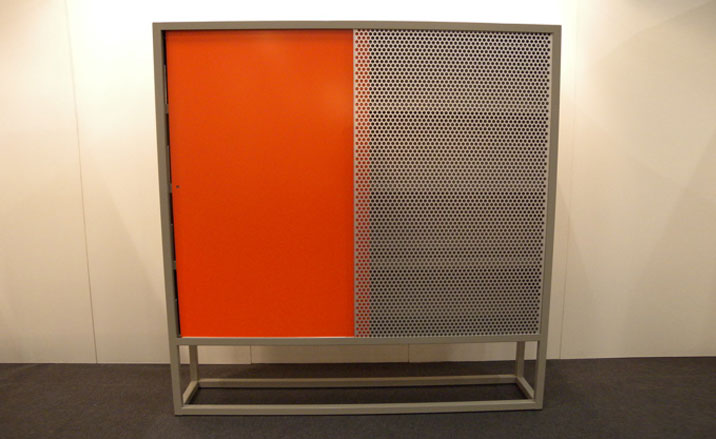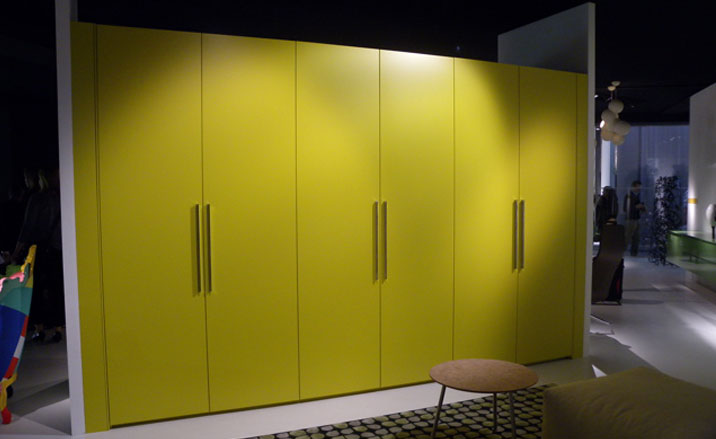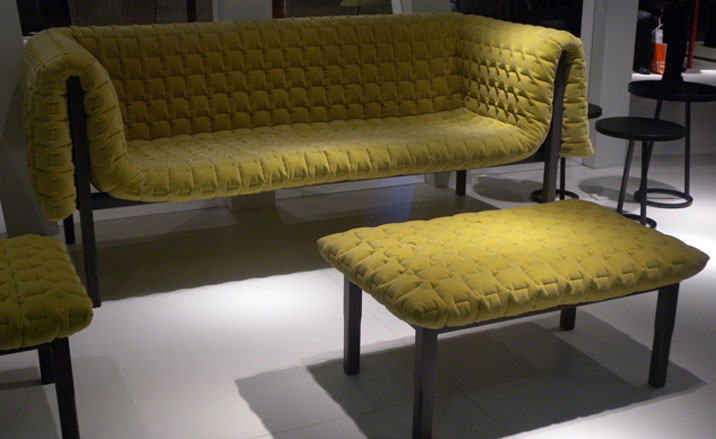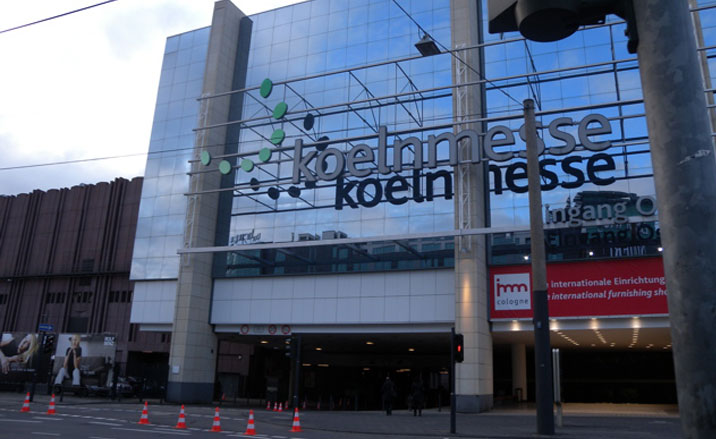IMM Cologne 2010

“There are no trends at all this year!” wailed one reporter into his mobile on the train back from the imm cologne furniture fair, and I wondered whether we had been to the same event. True, if you were looking for bling or all-expense-spared fashion statements, Cologne was not the place to be, but a shift in consciousness resulting from the economic downturn and environmental awareness was very much in evidence.
Apart from references to ‘eco’ issues and a few examples of blatant green-washing, there was a distinct lack of gimmicks and a general feeling of a return to simplicity and tradition. Giant knitted objects abounded as did examples of other handcrafts such as well-made wooden furniture and decoratively stitched coverings.
The fair organisers laid emphasis on conceptual strategies in design and the idea of community to varying degrees of success: the new ‘Pure Village’ section (designed by Dick Spierenburg) in Hall 11 was a hotchpotch of products and companies displayed in an architectural setting based around a central ‘square’. Here too were open lectures by designers such as Max Lamb explaining the processes involved in their work. Marcus Fairs from Dezeen hosted a number of talks with designers such as James Irvine, creative director at Thonet, and Tomás Alonso from OKAY studio in the D3 Design talents section which also housed numerous installations from design groups and colleges that explored experiments in new ways of living.
It has to be said that the imm seemed a little quiet on the opening two days, compared to the insane multitudes in Milan for example, but that seemed to suit the manufacturers quite well. “Milan is just for the bosses to visit” says Peter Wesner, partner at E15: “a new product has to be shown and fit into the collection, but it has to be sold as well and for that you need your salespeople to have a chance to meet and talk to the dealers”. Shipping the whole sales team to Milan is a highly expensive business, especially when budgets are tight, he explains, but the Cologne fair is still manageable in this respect.
Although some companies were conspicuous by their highly reduced presence, others, such as Classicon, made a reappearance at the fairground after several years of showing outside. One newcomer that particularly caught our eye was Jörg Schellmann whose severe yet beautifully proportioned collection of angular, steel-framed furniture was unashamedly modern and industrial-looking. Schellmann’s 40 year background as a contemporary art producer for the likes of Donald Judd and Sol le Witt is plain to see in his designs and a highly refreshing counterbalance to all the curvy biomimicry and formalism that has abounded over the last decade.
Outside the fair, the alternative Passagen events dotted around the city were highly disappointing and it was clear that many were feeling the pinch economically. Exceptions were the Designers Fair making its second appearance in a huge old building on the banks of the Rhine and Mike Meiré coming up trumps as usual with his ‘Revolving Realities’ multimedia installation in his own industrial atelier space for Dornbracht.
The imm cologne is about the business end of design and the furniture industry. It always was. It is not about stunning locations and ‘see and be seen’. It is one of the easiest fairs to access and move around, everything is clearly signposted and documented and you can find a taxi if you need one. And when you are done doing business you can hop on the Thalis to Paris Nord and three hours later you can be having dinner by the Seine and planning your route around the next fair, Maison et Objet, which conveniently launches directly afterwards.
Receive our daily digest of inspiration, escapism and design stories from around the world direct to your inbox.

The Designer’s Fair in Cologne hosted a large selection of young designers and independent makers. We were particularly pleased to see that Eva Marguerre’s lightweight Nido stool series has made it into production thanks to fibreglass manufacturer Masson.

We featured one of Bauke Knottnerus’ sensually knotted couches in Nick Knight’s now infamous Soft Furnishings photo shoot in last year’s July issue. This new Phat Knit piece shown at the Designer’s Fair is, at 120kg, what you might call extra chunky. It is a bed that can roll up to be a sofa, or seat, or whatever you want really.

German design graduate Robert Haslbeck’s Under-Koffer table series inspired by foldaway wallpapering tables was quite an eyecatcher in the D3 contest section for young designers.

Young Stockholm designer Johanna Körberg’s deconstructed chandelier Flamenco in the D3 contest was inspired by the emotion of Spanish dance and certainly had us clapping our hands in appreciation.

Young Swedish designers Sanna Lindström and Sigrid Strömgren’s Grand Central folding coffee table (demonstrated here by Sanna) opens out like a New York street map.

The Austrian architect Georg Bechter presented his Atelier Heimatstunden for the first time in Cologne at the imm this year and says he has been overrun with orders. This is not at all surprising given the stunning quality of his simple, yet beautifully made, table and bench combination made of solid pine and elm as well as a brilliant recessed lighting element that can be plastered into the wall.

The Munich-based designer Jörg Schellmann is best known for his artists’ editions for the likes of Donald Judd and Joseph Beuys - for the first time this year he presents his own collection of furniture at the imm. The industrial simplicity of the pieces and proportions make them artworks in their own right, like this lacquered steel chest of drawers with plastic containers called simply: ‘Storage’.

Jörg Schellmann’s new powder-coated steel ‘Library’ bookshelf with sliding aluminium doors in Hall 11 was one of the absolute highlights of the entire fair.

We have already grown to love the wood- and aluminium-framed versions of this unbelievably comfy Eve chair by Piero Lissoni at Cassina since its launch in Milan last year. But this new ivory lacquered version with softest cream leather has us completely rethinking the dining room colour scheme once again.

Cappellini presented its new tailor-made ‘Container System’ fitted wardrobes in Hall 11. A highly versatile system with three kinds of doors and five kinds of handles, it is just as lovely on the inside as out. This version with yellow matt lacquered doors had a pale, sage green interior

The manufacturer Schönbuch specialises in functional furniture for hallways. Their latest ventures into the bedroom with dressing tables and chests of drawers shown at the fair left us a little cold to be honest. This simple coat hook and key-rest called ‘Saucer’ by Cologne-based Eric Degenhardt, however, was spot on.

Our favourite new product from Ligne Roset this year has to be the new Ruché sofa series by Inge Sempé, here in yellow velvet.

Inge Sempé arrived tired but happy after a delayed train trip from Paris to celebrate the launch of her new Ruché sofa series on the Ligne Roset stand – she had been up half the night putting the finishing touches to a series of sketches for the press release.

Another new addition to the Ligne Roset collection at the imm was this Ottoman chair by Noé Duchaufour-Lawrance that is also available as a 2- or 3-seater sofa and stool.

Ligne Roset are celebrating their 150th birthday this year with 60 (!) new product ideas from 30 different designers. The La Plic wall light by Nathalie Dewez has to be one of the simplest but no less ingenious. The lateral bulb reflector and bent wire spring clip create lovely patterns of light that are particularly effective when hung in groups.

The entrance to Kolnmesse, the main fairground.

Two members of this year’s imm Trendboard, the designers Johanna Grawunder and Cecilie Manz designed spaces with products to illustrate the four main trends they had pinpointed for 2010 in the new Pure Village fair area. Here Grawunder’s interpretation of ‘Trickery’ as a sort of Dr Caligari’s cabinet featuring Bertjan Pot’s lovely revolving chandelier.

The little Italian architecture and design company Eugadesign were showing for the first time at the imm Cologne and brought this lovely new table lamp prototype in brushed aluminium.

The new Jalis sofa landscape from Cor comes mounted on its own podium. The inspiration is North African and heralds a cosy return to the sunken seating area and shagpile.

Walter Knoll’s new Black Series is a lovely monochrome take on a few of our favourites including the 369, the Vostra, PearsonLloyd’s Turtle and the MYchair by UN Studio/ Ben van Berkel.

The Walter Knoll Turtle from 2004 designed by PearsonLloyd is now available in black as part of their new Black Series ‘classics in a new look’.

Stuttgart-based producer Richard Lampert celebrated the 100th anniversary of the birth of German architect and designer Herbert Hirche by re-issuing a few more of his great modernist designs to the collection. We particularly liked this bar trolley design from 1956
-
 Usher opens up about breakfast playlists, banana pudding and why a glass tumbler is always on his rider
Usher opens up about breakfast playlists, banana pudding and why a glass tumbler is always on his riderOn the heels of a collaboration with Baccarat, the Grammy-winning singer-songwriter breaks down his entertaining tips. 'Hosting is an expression of how you feel about your guests and also who you are.'
-
 The beauty trends that will define 2026, from ultra-niche fragrances to anti-ageing dental care
The beauty trends that will define 2026, from ultra-niche fragrances to anti-ageing dental careAs we enter the new year, we speak to experts in fragrance, skincare, aesthetics, wellness and more about the trends that will be shaping the way we look
-
 The most stylish hotel debuts of 2025
The most stylish hotel debuts of 2025A Wallpaper* edit of this year’s defining hotel openings. Design-led stays to shape your next escape